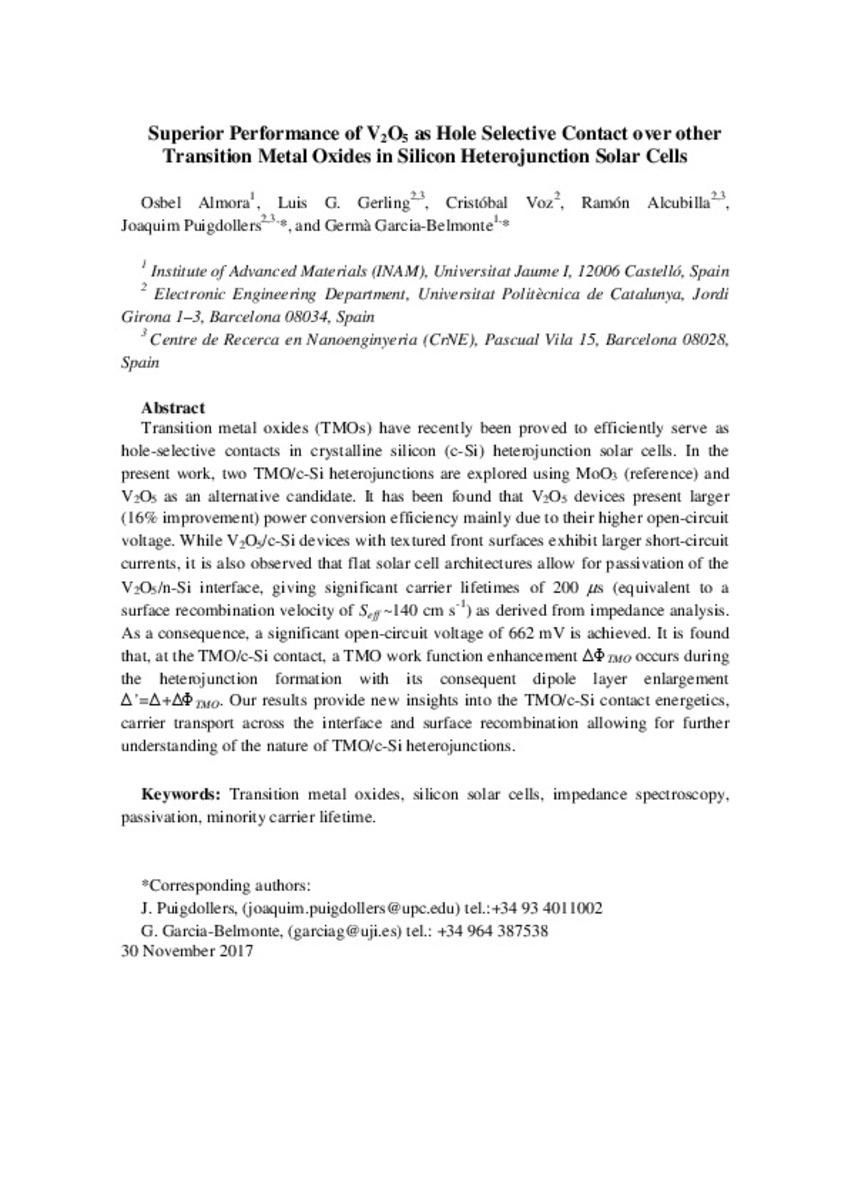Mostrar el registro sencillo del ítem
Superior Performance of V2O5 as Hole Selective Contact over other Transition Metal Oxides in Silicon Heterojunction Solar Cells
| dc.contributor.author | Almora Rodríguez, Osbel | |
| dc.contributor.author | Gerling, Luis Guillermo | |
| dc.contributor.author | Voz Sanchez, Cristobal | |
| dc.contributor.author | Alcubilla, Ramon | |
| dc.contributor.author | Puigdollers, Joaquim | |
| dc.contributor.author | Garcia-Belmonte, Germà | |
| dc.date.accessioned | 2018-01-16T18:50:24Z | |
| dc.date.available | 2018-01-16T18:50:24Z | |
| dc.date.issued | 2017 | |
| dc.identifier.citation | Almora, O., Gerling, L. G., Voz, C., Alcubilla, R., Puigdollers, J., & Garcia-Belmonte, G. (2017). Superior performance of V 2 O 5 as hole selective contact over other transition metal oxides in silicon heterojunction solar cells. Solar Energy Materials and Solar Cells, 168, 221-226. | ca_CA |
| dc.identifier.issn | 0927-0248 | |
| dc.identifier.issn | 1879-3398 | |
| dc.identifier.uri | http://hdl.handle.net/10234/171889 | |
| dc.description.abstract | Transition metal oxides (TMOs) have recently been proved to efficiently serve as hole-selective contacts in crystalline silicon (c-Si) heterojunction solar cells. In the present work, two TMO/c-Si heterojunctions are explored using MoO3 (reference) and V2O5 as an alternative candidate. It has been found that V2O5 devices present larger (16% improvement) power conversion efficiency mainly due to their higher open-circuit voltage. While V2O5/c-Si devices with textured front surfaces exhibit larger short-circuit currents, it is also observed that flat solar cell architectures allow for passivation of the V2O5/n-Si interface, giving significant carrier lifetimes of 200 ms (equivalent to a surface recombination velocity of Seff ~140 cm s-1) as derived from impedance analysis. As a consequence, a significant open-circuit voltage of 662 mV is achieved. It is found that, at the TMO/c-Si contact, a TMO work function enhancement ΔΦTMO occurs during the heterojunction formation with its consequent dipole layer enlargement Δ’=Δ+ΔΦTMO. Our results provide new insights into the TMO/c-Si contact energetics, carrier transport across the interface and surface recombination allowing for further understanding of the nature of TMO/c-Si heterojunctions. | ca_CA |
| dc.format.extent | 16 p. | ca_CA |
| dc.format.mimetype | application/pdf | ca_CA |
| dc.language.iso | eng | ca_CA |
| dc.publisher | Elsevier | ca_CA |
| dc.relation.isPartOf | Solar Energy Materials and Solar Cells, 2017, vol. 168, p. 221-226. | ca_CA |
| dc.rights.uri | http://rightsstatements.org/vocab/CNE/1.0/ | * |
| dc.subject | transition metal oxides | ca_CA |
| dc.subject | silicon solar cells | ca_CA |
| dc.subject | impedance spectroscopy | ca_CA |
| dc.subject | passivation | ca_CA |
| dc.subject | minority carrier lifetime | ca_CA |
| dc.title | Superior Performance of V2O5 as Hole Selective Contact over other Transition Metal Oxides in Silicon Heterojunction Solar Cells | ca_CA |
| dc.type | info:eu-repo/semantics/article | ca_CA |
| dc.identifier.doi | https://doi.org/10.1016/j.solmat.2017.04.042 | |
| dc.relation.projectID | We thank financial support by Ministerio de Economía y Competitividad (MINECO) of Spain under projects MAT2016-76892-C3-1-R, ENE2013-48629-C4-1-R and ENE2014-56237-C4-1-R, and also from Generalitat Valenciana (Prometeo/2014/020). O. A. acknowledges Generalitat Valenciana for a grant (GRISOLIAP2014/035). L. G. G. acknowledges Mexico’s grant program CONACyT for a grant. | ca_CA |
| dc.rights.accessRights | info:eu-repo/semantics/openAccess | ca_CA |
| dc.relation.publisherVersion | https://www.sciencedirect.com/science/article/pii/S0927024817302118 | ca_CA |
| dc.type.version | info:eu-repo/semantics/submittedVersion | ca_CA |
Ficheros en el ítem
Este ítem aparece en la(s) siguiente(s) colección(ones)
-
FCA_Articles [507]
Articles de publicacions periódiques







